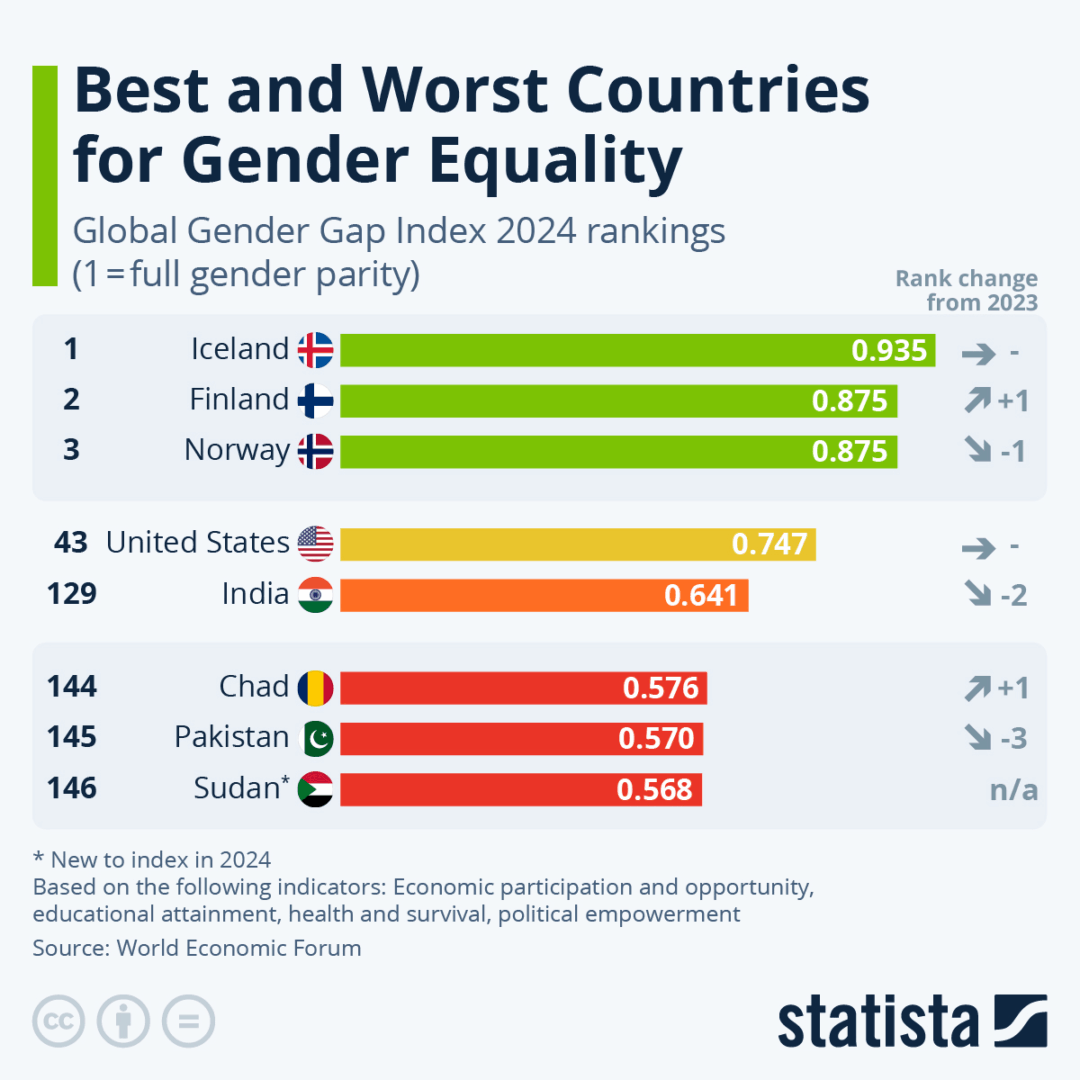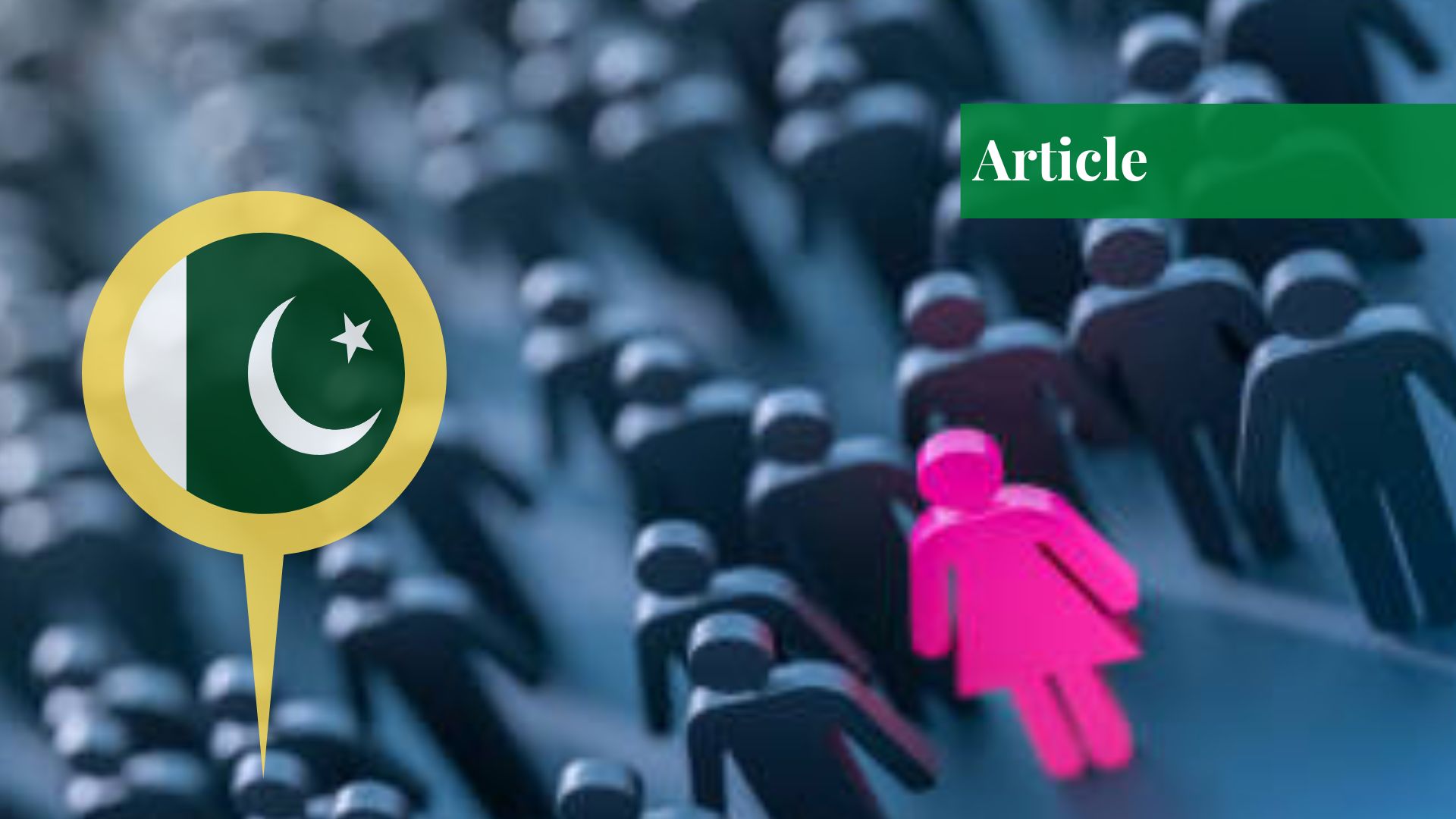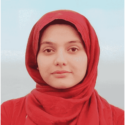Many reports, studies, and opinions have been published on the issue of gender equality. The World Economic Forum (WEF) also releases a global gender gap report which is an index that has been published annually since 2006 by the WEF—an independent international organization. The recent “Gender Gap Report 2024” is the 18th edition. It evaluates gender equality across global economies based on the availability and reliability of data, and the willingness of the participating countries.
The WEF collects this data from different international organizations such as the International Labour Organization (ILO), the United Nations (UN), the Educational, Scientific and Cultural Organization (UNESCO), statistical offices, and by conducting surveys.
The global report shares its findings in which each country gets a score from 0 to 1 in areas like economic participation, education, health, and political empowerment, with 1 indicating full gender equality. The report then ranks the countries from best to worst based on these scores and compares their overall performance. It also uses percentages to show how much of the gender gap has been closed or reduced in different areas.
It assesses gender inequality across four key dimensions:
- Economic Participation and Opportunity
- Educational Attainment
- Health and Survival
- Political Empowerment
According to the report, it will take 134 years for the world to reach full gender parity. As of now, parity is limited at 68.5%. Every year, the release is added to the corpus of work done on gender inequality. While each publication uses varying axes and different windows, they all represent the stark reality of inequalities ubiquitous in the world.
While gender inequality is a global problem, Pakistan’s indicators reflect the alarming disparities and violence faced by women. This year, the Global Gender Gap Report 2024 ranked Pakistan second last i.e. 145 out of 146 countries. It has an index of 0.57 which reflects a stark gender gap. Yet again, the report shows the same realities with different windows.
Key Dimensions
Economic Participation and Opportunity
Regarding economic participation, Pakistan has been ranked 143rd with an index of 0.36.
Women have limited opportunities for economic participation. The traditional norms around gender restrict women to the private realm, tending to the roles of reproduction and care. This is reflected by a mere 24% labor force participation rate of women compared to 80% participation of men.
Even the women who work are largely concentrated in the informal sector. The agricultural sector has women working in fields. Small-scale industries such as that of bangles employ women informally. Women in these working spaces are prone to health issues and harassment. They also work below minimum wage, increasing the exploitation of their labor. The report analyzes important issues such as the pandemic’s impact on women’s jobs as well. Many women had to leave work to take care of family during COVID, making it even harder for them to get back on their feet economically.
The women working in the formal sector also face multiple problems. They are often hired on short-term contracts without adequate pay or job security. Career progression is limited because of biases within the top management. According to the report, only 5.71% of the top management is women. Double burden—work inside and outside the house—adds to the woes of women. The lack of control of women over their finances belies the assumption that employment is equal to liberation or empowerment.
Women are significantly less represented in senior leadership roles, making up less than 6.1% of legislators, senior officials, and managers. There is also an income gap with women earning much less than men with only 62% getting equal pay in estimated earned income. Women’s participation in the labor force is very low at 30.4%, placing Pakistan among the lowest in the world in labor force participation rate and only 35% of women are professional and technical workers
Educational Attainment
In the educational achievement area, Pakistan ranks at 139th, which was previously 138th according to the report of 2023. The gender gap in literacy is at 67.1% resulting in no change from the previous year. While there has been some progress since 2006, many challenges still exist and these improvements are very slow compared to many other countries.
The parameters used on the education front are literacy rate, and enrollment in primary, secondary, and tertiary education. A relatively closed inequality on this front is due to an overall lack of education. Literacy among women is 51% while it is 73% among men. Enrollment in primary education for girls is 68% and for boys is 78%. Enrollment in secondary education for girls is 38% and for boys it is 45%. Enrollment in tertiary education for girls is 12.9% and for boys is 13.9%. A proliferation of universities in different districts of Pakistan has helped alleviate the problem by bringing universities closer to women. Nevertheless, higher education remains limited among women and men as well. The figures attest to the fact that an ostensibly closed gender gap in education (0.836) is misleading due to an overall lack of enrollment and education.
Health and Survival
In the overall health and survival area of the Global Gender Gap Index 2024, Pakistan ranks 132nd. The country ranks 1st in sex ratio at birth which is good but is at the 141st rank in healthy life expectancy which means a very poor quality of life. The parameter of health and survival shows a closed gender gap of 0.961. This is narrowly judged on the axes of sex ratio and life expectancy. These indicators obfuscate the number of health issues faced by women.
In the reproductive realm, unequal power relations limit women’s decisions on the number and spacing of children. The rights of women over their bodies are limited. Repeated pregnancies are reflected with an average fertility rate of 3.4 children per woman and the extent of abortions of unwanted children is reflected by a startling 2.2 million abortions per year. Usage of contraceptives is limited to 34% with the decision power largely resting with men.
Beyond the reproductive realm, women’s health issues include cervical cancer, breast cancer, ovarian cancer, anemia, and non-communicable diseases (NCDs) such as heart attack and diabetes. Women have unequal access to hospitals. Decision-making over their health mostly lies with the husband or in-laws. Restrictions of mobility and limited resources further increase inequalities on this front. This side of the health problem is not addressed in the report leading to an overestimation of the closed gender gap of 0.961.
Political Empowerment
In political empowerment, Pakistan ranks at 112th which is significantly lower than last year’s rank of 95th in this area. This reflects the underlying social relegation of women to the private sphere. Women hold 19.3% of parliamentary seats and a very low 6.3% of the ministerial positions. That too, is based on affirmative action of quotas for women. There is a 17% quota in the national and provincial assemblies and a 33% quota at the local level. Most of the seats are given to relatives and few reflect true representation. Regardless of this issue, affirmative action has to be continued to improve women’s access to the quarters of power that would otherwise be closed. This is specifically important to pass gender-sensitive legislation to improve systemic inequalities.
Apart from the inequality in the legislature, political empowerment remains a far dream on the ministerial level. Only 6% of the cabinet positions are held by women. Besides, the power of decision-making is concentrated with the leader of the House and party–mostly men.
The overall score for political empowerment has significantly decreased, which contributed mostly to Pakistan’s lower ranking.
Changing Realities
The state of affairs can be changed. Some countries have improved their rankings on the gender equality front by adopting multiple ways.
Iceland ranks first on the Gender Gap Report 2024. Back in 2006, it had closed 78% of its gender gap. Today, it has closed at 93.5%. Necessary legislation, strong commitment, and strict enforcement of laws allowed Iceland to reduce inequalities. Gender norms were redefined through gender-neutral textbooks. Legislation was passed to ensure equal pay in the workforce by companies. Parliament and cabinet were opened to include more women. Through a spate of laws and policy consistency, Iceland has secured first rank on gender parity closing 93.5% of the gender gap.
According to the report’s regional data, among 8 regions, European countries hold seven out of these top ten spots where, aforementioned Iceland remains at the top, leading for more than a decade. North America ranks second, Latin America and the Caribbean third, Eastern Asia and the Pacific fourth, Central Asia fifth, Sub-Saharan Africa sixth, South Asia seventh, and Middle East and North Africa comes last.

South Asia on the Global Gender Gap Index
South Asia ranks seventh in gender equality regional rank with a score of 63.7%, meaning that women in South Asia have about 63.7% of the opportunities that men have. The region has improved by a small 3.9% since 2006. Six out of the seven countries in the region are ranked below the top 100 globally where Bangladesh is first and Pakistan is last in the region.
Bangladesh has also taken different policy measures to improve the socio-economic conditions for women. Politically, Sheikh Hasina Wazed stands as the head of the government for a fifth term. Economically, the Grameen Bank provides success stories regarding avenues of poverty alleviation through microfinance for women. Without collateral, Grameen Bank provides women loans on a rotational basis in a group. Group members themselves act as collateral by providing an impetus for repayment to ensure others get the loan. Over the years, education attainment has also been increased for girls reaching a literacy rate of 74%. On the health front, Bangladesh provides a telling example of consistent policymaking on population planning. It has successfully reduced its average fertility rate to 1.9 children per woman by addressing both the demand and supply side of the population problem. Collectively, it stands at a rank of 99 in the Global Gender Gap Report 2024.
In Pakistan, there exists a successful case of the “Lady Health Worker Program.” A cadre of 10,000 LHWs was inducted to provide preventive and promotive healthcare to people at the grassroots level. It filled the yawning gap between people and the Basic Health Units (BHUs) that provide curative care. This home-grown model was different from the old brick-and-mortar approach and proved effective in bringing healthcare to the people who needed it the most. Significantly, this program increased the Contraceptive Prevalence Rate (CPR) from 12% in 1990 to 24% in 1994. The Lady Health Worker Program is yet another example of the case of improving gender equality in Pakistan.
Such policy prescriptions have been repeated ad nouseum. Some policies have been implemented but without due commitment and consistency. There is a need to ensure the continuation of existing policies. Strict enforcement of laws is also needed to deter gender-based violence.
Achieving gender equality is important for a nation’s sustainable growth and development. The report urges more effort from both the public and private sectors to close these gaps. Looking ahead, the report highlights the need to reshape labor markets, improve industry systems, and include gender issues in global changes like technology, climate action, and care economies. It calls for ongoing efforts and specific actions to achieve gender equality, stressing that this requires a well-rounded approach and continuous commitment from all parts of society.
Overall, Pakistan’s low performance in the global gender gap report reflects significant gaps in economic and political participation, as well as in educational attainment and quality of life. There’s been a decrease in the number of women holding political positions.A notable gap between men’s and women’s opportunities in education and jobs continues to exist. These challenges are some of the biggest factors bringing Pakistan down in the rankings. Pakistan’s performance in the report is a reminder of the persistent gender disparities that hinder our nation’s progress.
Pakistan should strive for gender equality through its policies and actions because women’s rights are human rights.
If you want to submit your articles and/or research papers, please check the Submissions page.
The views and opinions expressed in this article/paper are the author’s own and do not necessarily reflect the editorial position of Paradigm Shift.




